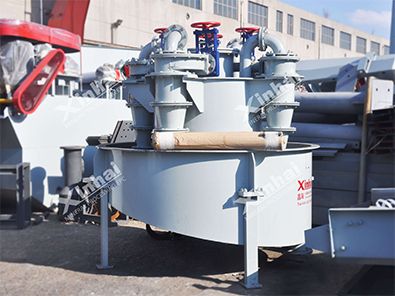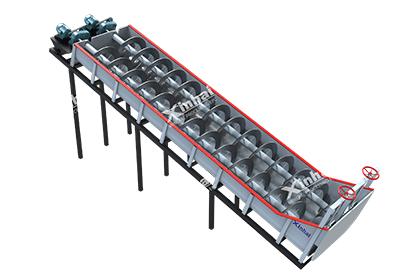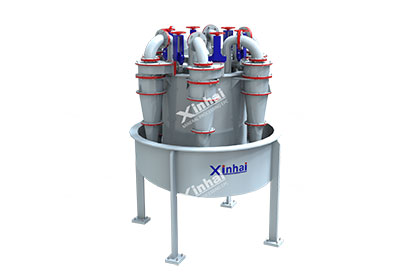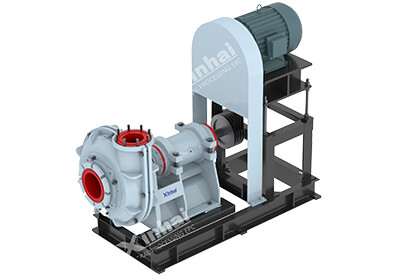Ultimate Guide to Hydrocyclone Maintenance
 Essow
Essow
 Sep 22, 2023
Sep 22, 2023
 2646
2646
If you want to know more details about equipment, solutions, etc, please click the button below for free consultation, or leave your requirements!
Mining operations rely on various equipment and technologies to extract valuable minerals from ore. One crucial component in the mineral processing circuit is the hydrocyclone, a device used for separating solid particles from liquids. Hydrocyclones play a vital role in achieving efficient particle classification and are widely employed in the mining industry.
To ensure the continuous and optimal performance of hydrocyclones, regular maintenance is essential. This article aims to explore the significance of maintenance in mining hydrocyclones and provide practical strategies for maintaining these critical pieces of equipment. By implementing effective maintenance practices, mining operators can enhance the lifespan of hydrocyclones, minimize downtime, and maximize productivity.
01 The Importance of Hydrocyclone Maintenance
BackMining hydrocyclones endure harsh operational conditions, including abrasive materials, high pressures, and corrosive environments. Without proper maintenance, these factors can lead to reduced efficiency, increased energy consumption, and premature equipment failure. Therefore, it is crucial to prioritize maintenance activities to ensure optimal performance and prolong the lifespan of hydrocyclones.
Regular maintenance offers several benefits, such as:
1. Efficiency and Performance
Hydrocyclones are designed to separate solid particles from liquid suspensions based on their size and density. Optimal performance is essential to achieve efficient particle classification and maximize mineral recovery rates. Regular maintenance ensures that hydrocyclones operate at their peak efficiency, resulting in improved separation efficiency and reduced wastage. By preventing blockages, erosion, and other issues, maintenance activities help maintain the desired flow pattern inside the cyclone, ensuring effective particle separation.
2. Equipment Longevity
Hydrocyclones are subjected to harsh operating conditions, including abrasive materials, high pressures, and corrosive environments. Over time, these conditions can lead to wear and tear, reducing the lifespan of the equipment. By implementing a comprehensive maintenance program, operators can identify and address potential issues before they escalate. Routine inspections, repairs, and timely replacements of worn-out components help extend the lifespan of hydrocyclones, minimizing the need for frequent equipment replacements and reducing overall operational costs.
3. Downtime Prevention
Unplanned equipment breakdowns can disrupt mining operations, resulting in costly downtime and reduced productivity. Hydrocyclones that are not properly maintained are more prone to failures and breakdowns. Through regular inspections, preventive maintenance, and proactive repairs, potential issues can be identified and resolved before they cause significant disruptions. By minimizing unexpected shutdowns, maintenance practices ensure the continuous operation of hydrocyclones, thereby maximizing overall production efficiency.
4. Safety Considerations
Maintenance activities also contribute to the safety of mining operations. Regular inspections help identify potential safety hazards, such as leaks, structural damage, or worn-out components that could lead to accidents or environmental incidents. By addressing these issues promptly, maintenance practices help create a safer working environment for mining personnel and reduce the risk of equipment failures that could compromise safety.
5. Cost Savings
Effective maintenance practices can lead to cost savings in several ways. By optimizing the performance of hydrocyclones, mining operators can achieve higher mineral recovery rates and reduce waste, resulting in increased revenue. Additionally, maintenance activities help prevent major equipment failures that would require costly emergency repairs or replacement of entire units. By extending the lifespan of hydrocyclones, maintenance minimizes the need for frequent capital expenditures, ultimately reducing operational costs and improving the overall profitability of mining operations.

(Hydrocyclone unit)
02 Key Maintenance Practices for Hydrocyclones
Back1. Regular Inspections
Regular inspections play a critical role in maintaining the performance and reliability of hydrocyclones. Here are some key aspects to consider when conducting regular inspections:
Visual Inspections
Visual inspections involve a thorough examination of the internal and external components of the hydrocyclone. This includes inspecting the liners, vortex finders, apexes, cyclone body, inlet and outlet connections, and any other relevant parts. Look for signs of wear, erosion, corrosion, blockages, leaks, or other damage. Inspecting the internal components may require dismantling the hydrocyclone, depending on its design. Ensure that proper safety precautions are taken during inspections.
Wear Assessment
Pay close attention to the condition of the liners, which are commonly subjected to abrasive materials. Examine the liners for signs of wear, such as thinning, scalloping, or uneven surfaces. Worn-out liners can compromise the separation efficiency of the hydrocyclone. Measure the remaining thickness of the liners using appropriate tools, such as calipers or ultrasonic thickness gauges, to determine if replacements are necessary.
Blockage Detection
Inspect the hydrocyclone for any signs of blockages or obstructions that may impede the flow of solids or liquids. Blockages can occur due to the accumulation of particles, debris, or scaling. Clear any blockages found during the inspection to ensure uninterrupted operation and optimal performance.
Integrity Checks
Assess the structural integrity of the hydrocyclone components. Look for cracks, fractures, or any signs of deformation that may compromise the integrity of the equipment. Ensure that all connections, such as bolts or clamps, are properly tightened and secure. Address any structural issues promptly to prevent further damage or potential safety hazards.
Leakage Evaluation
Check for leaks around the hydrocyclone, including the inlet and outlet connections, apex, and vortex finder. Leaks can indicate worn-out seals, damaged gaskets, or loose connections. Address any leaks to avoid loss of valuable materials, operational inefficiencies, or safety risks.
Performance Analysis
Evaluate the performance of the hydrocyclone by monitoring key parameters such as flow rates, pressure differentials, and separation efficiency. Compare the current performance with previous records or manufacturer specifications to identify any deviations or degradation. Analyze the collected data to determine if adjustments or maintenance actions are necessary to restore optimal performance.
Documentation and Record-Keeping
Maintain a comprehensive record of inspections, including dates, findings, and any actions taken. This documentation serves as a reference for future inspections and aids in identifying trends or recurring issues. Keep track of any maintenance activities performed, such as repairs, replacements, or adjustments, and record the associated costs. Proper record-keeping helps in developing maintenance schedules, tracking equipment performance, and facilitating communication among maintenance personnel.
Compliance with Safety Standards
During inspections, ensure that all safety protocols and guidelines are followed. Adhere to relevant safety regulations and wear appropriate personal protective equipment (PPE). If necessary, involve qualified maintenance personnel or follow manufacturer recommendations to ensure inspections are conducted safely and effectively.

(Hydrocyclone unit)
2. Liner Maintenance
Liner maintenance is a crucial aspect of hydrocyclone maintenance. The liners in hydrocyclones are exposed to abrasive materials and play a significant role in achieving efficient particle separation. Here are some key points to consider when performing liner maintenance:
Inspection
Regular inspection of the liners is essential to identify signs of wear, erosion, or damage. Inspect the liners visually to look for thinning, scalloping, or uneven surfaces, which can indicate wear. Inspect both the interior and exterior surfaces of the liners to ensure a comprehensive assessment. It is important to closely examine the area near the apex and vortex finder, as these regions often experience higher wear rates.
Wear Measurement
Measure the remaining thickness of the liners to assess their wear level accurately. Various methods can be employed to measure liner thickness, such as using calipers, ultrasonic thickness gauges, or specialized tools provided by the manufacturer. Compare the measured thickness with the original liner thickness to determine the amount of wear. This information helps in deciding whether the liners need replacement or if they can still function effectively.
Liner Replacement
When the liners show significant wear or damage that affects their performance, replacement is necessary. Follow the manufacturer's guidelines for liner replacement, including the recommended frequency and procedure. It is essential to use high-quality replacement liners that are designed to withstand the abrasive environment. Consider using wear-resistant materials or liners with protective coatings to enhance their durability and prolong their lifespan.
Installation
Proper installation of new liners is crucial to ensure their effectiveness. Follow the manufacturer's instructions for liner installation, including the correct alignment and tightness of the liners. Improper installation can lead to misalignment, decreased separation efficiency, or premature wear. Use appropriate tools and techniques to secure the liners in place, such as bolts, clamps, or other fastening mechanisms. Ensure that all connections are properly tightened and sealed to prevent leaks.
Maintenance Schedule
Establish a maintenance schedule for liner inspections and replacements based on the specific operating conditions and the wear characteristics of the liners. The frequency of inspections and replacements may vary depending on factors such as the abrasive nature of the processed materials, flow rates, and operational hours. Regularly monitor the wear rates and performance of the liners to determine the optimal timing for replacements and avoid unexpected failures.
Record-Keeping
Maintain detailed records of liner maintenance activities, including inspection dates, wear measurements, replacements, and associated costs. This documentation helps track the lifespan of the liners, identify trends in wear rates, and plan future maintenance activities effectively. It also serves as a valuable reference for troubleshooting or warranty claims.
Optimization and Upgrades
Consider optimizing the design or material selection of liners to improve their performance and longevity. Consult with hydrocyclone manufacturers or specialized professionals to explore the available options for liner upgrades. Upgrades may include using advanced materials, innovative designs, or optimized liner configurations to enhance wear resistance and separation efficiency.

(Hydrocyclone units)
3. Cleaning and Flushing
Regular cleaning of hydrocyclones is essential to remove accumulated solids or debris that can impair their performance. Flushing the hydrocyclone with clean water can help dislodge and remove any particles or blockages. It is advisable to establish a routine cleaning schedule based on the specific operational requirements and the nature of the processed materials.
4. Pressure Monitoring
Monitoring the pressure differentials across the hydrocyclone is crucial for identifying potential issues. Deviations from the normal pressure differentials may indicate blockages, worn liners, or other operational problems. Implement pressure monitoring systems and establish appropriate ranges for normal operation. Regularly calibrate and verify these systems to ensure accurate measurements.
5. Apex and Vortex Finder Inspection
The apex and vortex finder are critical components that influence the hydrocyclone's performance. Inspect these parts for erosion, damage, or blockages regularly. Any issues with the apex or vortex finder can impede proper fluid flow and separation efficiency. Replace or repair these components as needed to maintain optimal performance.
6. Lubrication and Bearing Maintenance
If the hydrocyclone is equipped with bearings, ensure proper lubrication to minimize friction and wear. Follow manufacturer recommendations for lubrication intervals and use suitable lubricants. Regularly inspect bearings for signs of wear or damage and replace them as necessary.
7. Professional Support and Training
Engage with hydrocyclone manufacturers or specialized maintenance professionals to receive guidance on maintenance best practices. Training operators and maintenance personnel on proper inspection techniques, maintenance procedures, and safety protocols is crucial for effective maintenance and equipment longevity.
8. Data Monitoring and Analysis
Implementing condition monitoring systems can provide valuable insights into the performance of hydrocyclones. Collect and analyze data related to flow rates, pressure differentials, and separation efficiency to identify trends or anomalies. This information can guide maintenance decisions and help optimize hydrocyclone operations.
03Conclusion
BackMaintenance is a critical aspect of ensuring the optimal performance and longevity of mining hydrocyclones. Regular inspections, cleaning, and repairs can prevent major failures, enhance efficiency, and minimize downtime. By implementing effective maintenance strategies outlined in this article, mining operators can maximize the lifespan of their hydrocyclones and optimize mineral processing operations.
Investing in a proactive maintenance approach, including regular inspections, liner maintenance, cleaning and flushing, pressure monitoring, apex and vortex finder inspection, lubrication and bearing maintenance, and data monitoring and analysis, will yield significant benefits. These practices contribute to improved separation efficiency, extended equipment lifespan, and minimized downtime, ultimately leading to higher productivity and profitability in mining operations.
It is crucial for mining companies to prioritize maintenance activities and allocate resources for training personnel and engaging with hydrocyclone manufacturers and maintenance professionals. By promoting a culture of maintenance excellence and implementing these strategies, mining operators can ensure the reliable and optimal performance of their hydrocyclones, even in demanding operating environments.
In conclusion, maintenance plays a vital role in the effective operation of mining hydrocyclones. By following a comprehensive maintenance program that includes routine inspections, timely repairs, and proactive measures, mining companies can maximize the lifespan of their hydrocyclones, improve separation efficiency, and minimize downtime. Investing in maintenance is an investment in the long-term success and sustainability of mining operations.
Maximizing Ball Mill Performance: A Comprehensive Guide to Effective Maintenance
Comprehensive Guide to Flotation Machine Maintenance
A Comprehensive Guide to Thickener Maintenance
Comprehensive Guide to Magnetic Separator Maintenance.
Comprehensive Guide to Gravity Separator Maintenance
 +86 18716000713
+86 18716000713 xlyin@xinhaimining.net
xlyin@xinhaimining.net




 Message
Message Chat Now
Chat Now


















